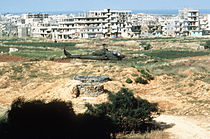| Multinational Force Beirut – Lebanon | |
|---|---|
| Force multinationale de sécurité à Beyrouth (French) Forza Multinazionale in Libano (Italian) | |
Clockwise from top left: United States Navy LARC-V landing in Beirut, September 1982; Lebanese Army in Beirut, 1982; Italian President Sandro Pertini in Lebanon during a visit to the Italian contingent in 1983; PLO office in Sidon, 1982; Fighter jet taking off from French aircraft carrier Foch off the coast of Lebanon, 1983; French Aérospatiale SA 330 Puma helicopters in Beirut, Lebanon, 1983; USMC Bell AH-1T SeaCobra helicopter on patrol outside the city of Beirut, May 1983; U.S. Marines on patrol in Beirut, April 1983; Israeli troops in Sidon, August 1982; Green Line, Beirut 1982 | |
| Active | August 25, 1982 – March 31, 1984 |
| Disbanded | March 1984 |
| Countries | |
| Role | Peacekeeping mission Interposition force[1] |
| Garrison/HQ | Beirut, Lebanon |
| Engagements | Lebanese Civil War |
| Commanders | |
| USMNF (Task Force 62) (August 1982 – February 1984) | Col. James M. Mead 32nd MAU (August – October 1982) Col. Thomas M. Stokes, Jr. 22nd MAU (November 1983 – February 1984) |
| British Forces (February 1983 – February 1984) | Lt. Col. John de P. Ferguson 1st The Queen's Dragoon Guards (September 1983 – January 1984) |
| French Forces (August 1982 – March 1984) | 11th Airborne Division, B. Gen. Jacques Granger (August – September 1982) 11th Airborne Division, B. Gen. Jacques Granger (September 1982 – January 1983) |
| Italian Forces (August 1982 – January 1984) | Paratroopers Brigade Folgore and San Marco Battalion, B. Gen. Franco Angioni (August 1982 – January 1984)[2] |
| Insignia | |
| Patches | |
The Multinational Force in Lebanon (MNF) was an international peacekeeping force created in August 1982 following a 1981 U.S.-brokered ceasefire between the Palestine Liberation Organization (PLO) and Israel[3] to end their involvement in the conflict between Lebanon's pro-government and pro-Syrian factions. The ceasefire held until June 3, 1982, when the Abu Nidal Organization attempted to assassinate Shlomo Argov, Israel's ambassador to London.[4] Israel blamed the PLO and three days later invaded Lebanon. West Beirut was besieged for seven weeks before the PLO acceded to a new agreement for their withdrawal. The agreement provided for the deployment of a Multinational Force to assist the Lebanese Armed Forces in evacuating the PLO, Syrian forces and other foreign combatants involved in Lebanon's civil war.
The four-nation MNF was created as an interposition force meant to oversee the peaceful withdrawal of the PLO.[5] The participants included the U.S. Multinational Force (USMNF), which consisted of four different Marine Amphibious Units (MAUs); British 1st Queens Dragoon Guards armoured reconnaissance regiment; the 1st inter-arm Foreign and French Brigade, 4 Foreign Legion Regiments, 28 French Armed Forces regiments including French and Foreign paratroopers, units of the National Gendarmerie, Italian paratroopers from the Folgore Brigade, infantry units from the Bersaglieri regiments and Marines of the San Marco Regiment. Additionally, the MNF was in charge of training various units of the Lebanese Armed Forces.[6]
The relatively benign environment at the beginning of the mission gave way to chaos as the civil war re-escalated following the assassination of President-elect Bashir Gemayel in September 1982. Subsequent political and military developments on the ground caused the MNF to be viewed not as a peacekeeper, but as a belligerent.[7] In early 1984, after it became apparent that the government of Lebanon was no longer able to impose its will on warring factions as they entered Beirut and hostilities renewed,[7] the MNF ended its presence mission in Beirut and went offshore before completely leaving Lebanon in July of the same year in the aftermath of the October 1983 barracks bombing that killed 241 U.S. and 58 French servicemen.[8] It was replaced by the United Nations Interim Force in Lebanon (UNIFIL) already present in Lebanon since 1978.
- ^ "Chapter 5: Logistic Support for Peace Support Operations". NATO Logistics Handbook. NATO. 1997. p. 503.
- ^ Frank, Benis M. (1987). U.S. Marines in Lebanon, 1982–1984. Washington, D.C.: History and Museums Division, USMC. pp. 161–162.
- ^ "The Reagan Administration and Lebanon, 1981–1984". U.S. Department of State. Office of the Historian.
- ^ "The Lebanon War (1982)". Ynetnews. Yedioth Internet. November 30, 2008.
- ^ Zenko, Micah (February 2, 2014). "When Reagan Cut and Run". Foreign Policy.
- ^ Jordan, David (2005). The History of the French Foreign Legion: From 1831 to the Present Day. Globe Pequot. p. 103. ISBN 978-1-59228-768-0.[permanent dead link]
- ^ a b Robert L. J. Long; et al. (December 20, 1983). Report Of The DoD Commission On Beirut International Airport Terrorist Act, October 23, 1983 (Report). U.S. Department of Defense.
- ^ Frank, Benis M. (1987). U.S. Marines in Lebanon, 1982–1984. Washington, D.C.: History and Museums Division, USMC. p. 139.










